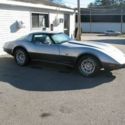1978 Corvette Stingray Anniversary Edition , L82
| Make: | Chevrolet |
| Model: | Corvette |
| SubModel: | Stingray |
| Type: | Coupe |
| Year: | 1978 |
| Mileage: | 29500 |
| VIN: | 1Z87L8S420595 |
| Color: | Silver |
| Engine: | L82 |
| Cylinders: | 8 |
| Transmission: | Automatic |
| Drive type: | RWD |
| Interior color: | Black |
| Drive side: | Left-hand drive |
| Vehicle Title: | Clean |
| Item location: | Atlanta, United States |
1978 Chevrolet Corvette Additional Info:
"1978 was the Corvette's twenty fifth anniversary, and all 78's featured silver anniversary nose and fuel door emblems. A newfastbackrear window was the most dramatic and noticeable styling change, giving the ten-year-old C3 Corvettebody stylea fresh lease on life. The fixed-glass fastback benefited both aerodynamics and increased the usable luggage space behind the seats while improving rearward visibility in the bargain. A shade was installed that could be pulled forward to cover the rear compartment to protect cargo and carpet against the unrelenting sun. The tachometer and speedometer were redesigned to match the new “aircraft styled” center console and gauge cluster first seen the previous year. Redesigned interior door panels were also new as well as an actual glove box was added in front of the passenger seat, replacing the map pockets of previous years. Available options now included power door locks, a power antenna, dual rear speakers and a CB radio.[6]The optional convenience group, introduced the previous year, now included intermittent (delay) wipers, floor mats, and the passenger side vanity mirror was an upgraded illuminated unit. The base L-48 engine generated 185hp (138kW); Those destined for California or high altitude areas produced 175hp (130kW). Gone was the chrome-plated ignition shielding over the distributor, replaced with a metal-lined black plastic unit. The single-snorkel air intake used since 1976 was changed to a dual-snorkel set-up on L-82 equipped cars helping to boost that output to 220hp (164kW). L-82 engines were also now fitted with an aluminum intake manifold which saved 24pounds compared to the cast iron unit of previous years. The Corvette converted to metric tires with the P225/70R15 as standard. Wider P255/60R15 tires were available as an option and required fender trimming from the factory for clearance. The fuel tank capacity increased from 17 gal to 24 gal on all cars. To make room for the larger tank, a smaller (P195/80D15) space saverspare tirewas utilized.
Two special editions were offered to celebrate Corvette's 25th year. Before he retired, Bill Mitchell had suggested a Silver Anniversary model in his favorite color-silver, appropriately enough-and it appeared as the $399 B2Z option package. The first two-tone paint option offered since 1961, it presented silver over a gray lower body with a separating pinstripe, plus aluminum wheels and dual "sport" outside mirrors as mandatory options, which added another $380 to the cost. 6502 Indy-500 Pace car replica editions were produced featuring Black/silver two-tone paint, front and rear spoilers, mirror-tint roof panels and contoured sport seats. Reviewers praised the car's classic strengths including its impressive straight-line numbers, especially an L48/automatic's 7.8second 0-60 time and top speed of 123mph (198km/h), and noted its more refined, less rattling ride. On the other hand, they continued to note its weaknesses, like a rear-end that tended to step out during sharp maneuvers and a cabin that was still cramped and uncomfortable.
Road & Tracktook a 1978 L82 to 60mph (97km/h) in just 6.6seconds, 127mph (204km/h) flat out, and covered the quarter-mile in 15.3seconds @ 95mph.[33]
1979 saw the crossed-flag emblems on the nose and fuel door revert to those seen on the '77 model. Three popular features introduced on the '78 pace car replicas made it into this year's production: the new bucket seats, the front and rear spoiler package, and the glass roof panels. The new lightweight “high back” seats were made standard equipment. The new seats had better side bolster, provided easier access to the rear storage area, and the seat pair resulted in a weight reduction of about 24pounds. The bolt-on front and rear spoilers were offered as an option and nearly 7,000 cars were ordered so equipped. Functionally, the spoilers decreased drag by about 15% and increased fuel economy by about a half-mile per gallon. A bigger hit were the glass mirror-tint roof panels, now a regular option, with nearly 15,000 cars so fitted despite their costing $365. All T-tops were now wired into the standard anti-theft alarm system. Tungsten-halogen high-beam headlights became standard as did an AM-FM radio, and for the first time a cassette tape player could be added as a $234 option.[34]Heavy duty shock absorbers could now be ordered without the full Gymkhana suspension. An auxiliary electric engine cooling fan was first installed, but only on L-82 equipped cars with air conditioning.[35]Rocker panels and rear window trim were painted black.[32]Output for all engines increased due to new "open flow" mufflers. The dual-snorkel air intake introduced on L-82 cars the previous year was now fitted to all cars and the base engine now generated 195hp (145kW). The optional L-82 engine increased to 225hp (168kW). This was the final year a manual gearbox could be ordered with the L-82 engine. This was also the last year for the M21 close-ratio 4-speed, a gearbox that, as in previous years, required the optional L-82 engine.[15]A wide-ratio 4-speed was available for all cars. Noteworthy is that about 82% of the cars were ordered with manual transmissions in 1968. In '79, less than 20% of the cars were delivered with manual gearboxes.[6]This year reached an all-time high in Corvette popularity. Production hit its peak in 1979 at 53,807, a record that stands to this day.[36]" wikipedia























